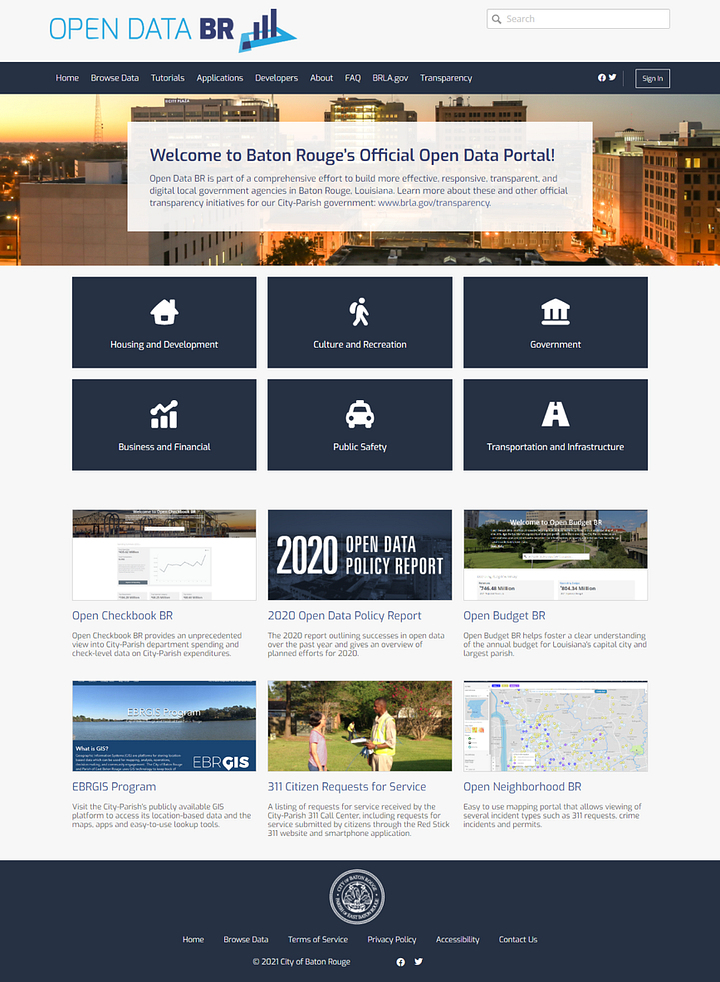Baton Rouge, Louisiana, USA
In Baton Rouge, Data and Community Health Go Hand-in-Hand.
Project Type:
Communications, Equity, Health and Wellness, High-Performing Government, Infrastructure

2024 Gold Certification
Baton Rouge, Louisiana, used data to make several improvements to the way the City buys goods and services. For example, when a disparity study showed that women- and minority-owned businesses were getting only 4 percent of the City’s contract dollars, Mayor Sharon Weston Broome set a goal of raising that to 25 percent. In addition, city leaders used data to dig into delays in processing professional services. Subsequent changes cut the procurement timeline from 51 to 20 days.
2021 Silver Certification
Created one of the nation’s only Community Vaccination Centers to digitize service delivery and hosted over 1,300 virtual meetings that served over 10,000 participants.
Used a data-driven approach to analyze historic contracting data, identify gaps in contracting with small, minority-women-and veteran owned businesses.
Data helped map health disparities by ZIP code and correlated health data to Census tracts to demonstrate how a person’s residency is directly connected to their quality of life, including expected lifespan, access to food, and exposure to crime.
Using Data to Build a Healthier Baton Rouge
That Baton Rouge has one of the most innovative public health programs in the country might come as a surprise, considering that the Louisiana capital doesn’t have a local health department. Health policy is established by the City of Baton Rouge/East Baton Rouge Parish, a consolidated form of government that encompasses the city and parish (county) limits.
But that hasn’t stopped the City-Parish from addressing its community health challenges in collaborative, creative ways. The centerpiece of this work has been the Mayor’s Health City Initiative (MHCI), which launched in 2010. When Mayor-President Sharon Weston Broome took office, she expanded and grew the program, which is also referred to as “Healthy BR.”
The collaborative, data-driven strategy is enabled in part by the investment Baton Rouge has made in recent years to build a strong data foundation and culture. The City-Parish, for example, has received technical assistance from expert partners through What Works Cities (WWC) to strengthen its performance and analytics, open data, and data governance capacities. By leveraging the City-Parish’s in-house data experts, the MHCI and its partner hospitals have been able to tell a data-driven story that raises public awareness of the troubling extent to which where a person lives determines their health. There is a growing consensus among public health experts that this trend creates disparities across geographic and racial lines.
This reality is highlighted in Baton Rouge’s Joint Community Health Needs Assessment (CHNA), a federally mandated report that hospitals are required to file every three years under the Affordable Care Act. In 2015, the five local area nonprofit hospitals came together to write the nation’s first joint CHNA and joint Community Health Implementation Plan (CHIP). Healthy BR’s 2018 CHNA report ramped up the role of data, mapping health disparities by ZIP code and correlating health data to Census tracts to demonstrate how a person’s residency is directly connected to their quality of life, including expected lifespan, access to food, and exposure to crime.
“The visual, data-driven approach helped heighten awareness among our stakeholders that the social determinants of health make up the majority of someone’s health,” says Jared Hymowitz, who directs MHCI on behalf of Mayor Broome. “And that helps us get traction for this work.” One result of the initiative: The City-Parish has worked with the Humana Foundation and the Blue Cross and Blue Shield of Louisiana Foundation to raise nearly $4 million to address food insecurity in Baton Rouge.
Hymowitz worked closely with the City-Parish’s Geographic Information System (GIS) team to visualize the data for the 2018 report. He’ll do so again for the 2021 version, which will focus on COVID-19 and hospitalization disparities, as well as the correlation between crime and health.
“The exciting thing is that publicly available data is light years from where we were when we wrote the last assessment,” Hymowitz says. “There’s a lot of impactful storytelling we can do around community health challenges.” For example, in 2018, MHCI worked with the Louisiana Department of Health to identify the average age of death by ZIP code. Today, MHCI can estimate a person’s life expectancy based on the Census tract in which they live, generating valuable data and supporting analyses that guide how the community responds to health challenges.
“The goal is simple: build a healthier Baton Rouge. We know getting there requires sharing data and expertise across key organizations. That kind of collaboration is the best way to tackle common health challenges like obesity and diabetes.”
Tapping Growing Data Potential
Warren Kron, the City-Parish’s GIS manager, works with his colleagues in the Department of Information Services and GIS section to make such storytelling possible across city-parish governments. During the pandemic, his team helped create a COVID-19 dashboard to provide comprehensive information about virus cases that could help policymakers and hospitals manage the crisis. He compiled information from the Louisiana Department of Health, coroner reports and 911 calls, and then mapped everything.

“We aggregated the data to Census tract geographies to identify the hotspots in our parish, which the Mayor’s Office then used to decide where to set up testing locations and direct other response resources,” Kron says.
Initially for internal use, the dashboard went public in May 2020. During weekly calls, Baton Rouge area hospital administrators, the Mayor’s Office, and other stakeholders used data from the tool to guide key COVID-19-related decisions and coordinate policies. Kron’s team has since automated much of the data to minimize upkeep and maintain current information, and the dashboard now also displays vaccination information. Such initiatives are possible because the City-Parish decided several years ago to consolidate its GIS staff spread across various departments into a single team.
But today, centralized in one office and championed by Director of Information Services, Eric Romero, the GIS team leverages data sets and creates powerful tools that help policymakers and on-the-ground staff deliver services. One example: The GIS team helped city-parish street maintenance crews use geographic data drawn from residents’ 311 service requests to more efficiently fix potholes. Kron’s team built an app that mapped pothole locations, and workers eliminated a backlog of 3,000 pothole requests in three months.
“We have seen tremendous gains in efficiency,” Kron says, noting that while a lot of the data his team manages has been around for a while, it has never been easier to map it and make it digestible. “It’s the application of all this data that matters.”
The City-Parish plans to rebrand the GIS team as the data, analytics, and performance office — still within the Department of Information Services, but with a name and function more closely aligned with the role this team serves for city-parish government. This office will serve as the central place for internal and external stakeholders to get data, access analyses, review data trends, and more. That will build on Baton Rouge’s considerable open data resources, which cover everything from the budget and spending to neighborhood-level crime and 311 requests. A core goal of all this work is to empower people with information.

“We want to see residents and the community use data to make their own decisions. The goal is never data for its own sake. All of this work is ultimately about giving people the ability to understand their community, so they can help make it a better place.”